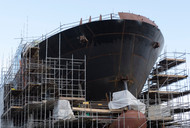Why PAUT is the Go-To NDT Method for Marine Applications
Posted by VERMON NDT on Jul 22nd 2025
In the harsh and demanding marine environment, the ability to quickly and accurately assess the condition of structural components is critical to ensuring safety, reliability, and compliance. Phased Array Ultrasonic Testing (PAUT) has emerged as a superior nondestructive testing (NDT) method for marine applications—offering unmatched versatility, precision, and efficiency.
Top 4 Reasons Why PAUT Stands Out in the Marine Sector
- Faster, More Efficient Inspections
Unlike conventional ultrasonic testing (UT), PAUT utilizes electronically controlled multi-element probes to inspect large areas and complex geometries in a fraction of the time. This reduces vessel downtime, minimizes dry dock costs, and accelerates maintenance schedules—key advantages in commercial shipping, naval operations, and offshore energy sectors.
- Superior Flaw Detection
PAUT’s beam steering and focusing capabilities give inspectors a three-dimensional look into materials. Whether inspecting dissimilar metal welds on ship hulls or monitoring corrosion under insulation (CUI) on offshore risers, PAUT delivers enhanced detection of flaws such as cracks, pits, and disbonds—especially in geometrically complex or difficult-to-access areas.
- Increased Safety with No Radiation
Unlike radiography (RT), PAUT poses no radiation risk, making it safer for both operators and surrounding personnel. This is particularly beneficial in confined or continuously staffed environments such as naval vessels, cruise ships, and offshore rigs.
- Cost-Effective Over Time
While the upfront cost of PAUT equipment can be higher than conventional UT, the efficiency, accuracy, and reduction in secondary inspections or rework often result in lower long-term costs. Plus, the digital recordkeeping and traceability provided by PAUT facilitate better lifecycle management of marine assets.
5 Common Marine Applications for PAUT
- Hull Inspections: Identify corrosion and cracking that could compromise the watertight integrity of vessels.
- Weld Testing: Evaluate the quality of critical welds on ship structures, storage tanks, and pressure vessels.
- Offshore Platform Components: Inspect risers, conductors, and subsea pipelines for early signs of degradation.
- Propeller Blade Analysis: Detect fatigue cracks and erosion damage that could lead to catastrophic failure.
- Thickness Measurements: Accurately assess remaining wall thickness to inform repair and replacement decisions.
Why Probe Quality Matters: The Vermon NDT Difference
All the sophistication of PAUT is only as reliable as the probe it uses. For marine inspections where accuracy and repeatability are non-negotiable, high-quality and stable probes are essential.
Vermon NDT (http://pautprobes.com ) offers industry-leading PAUT probes designed for harsh environments with precise beam control, and long-term durability. Their probes are trusted by marine inspectors worldwide to deliver consistent, high-resolution data—whether you're scanning a corroded hull plate or inspecting subsea welds at depth.
In an industry where inspection results directly impact safety, compliance, operational continuity, and ultimately, the bottom line, using the best PAUT probes is not optional—it’s essential.
**Explore the full range of precision-engineered PAUT probes at **pautprobes.com. When the ocean demands the best, Vermon NDT helps you rise to the challenge.

